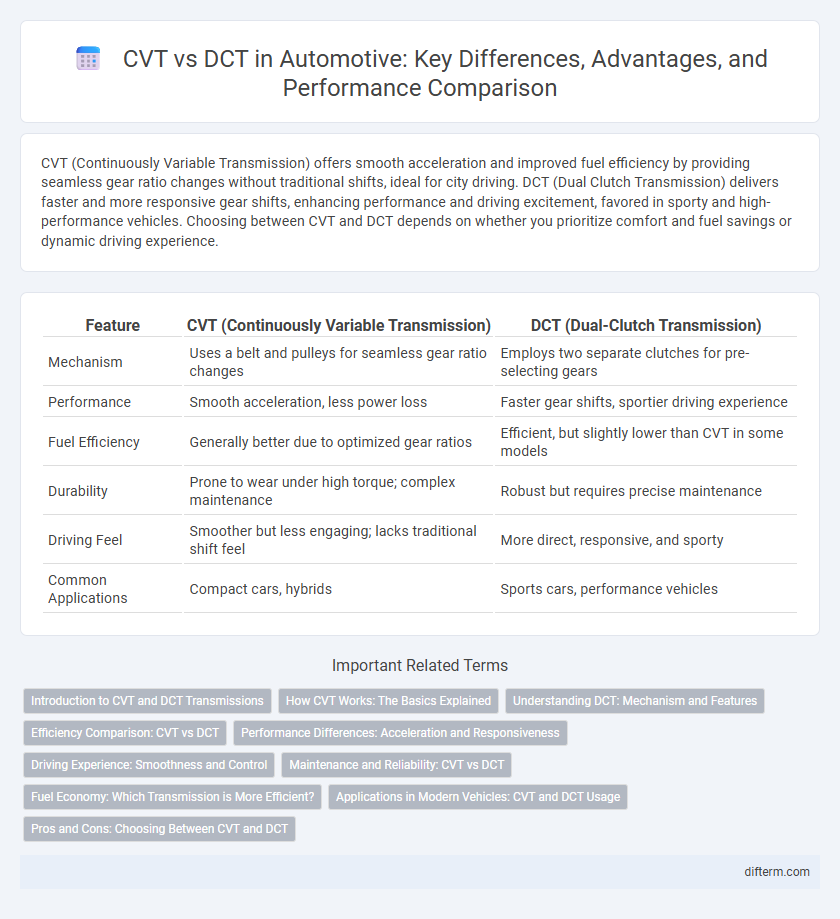CVT (Continuously Variable Transmission) offers smooth acceleration and improved fuel efficiency by providing seamless gear ratio changes without traditional shifts, ideal for city driving. DCT (Dual Clutch Transmission) delivers faster and more responsive gear shifts, enhancing performance and driving excitement, favored in sporty and high-performance vehicles. Choosing between CVT and DCT depends on whether you prioritize comfort and fuel savings or dynamic driving experience.
Table of Comparison
| Feature | CVT (Continuously Variable Transmission) | DCT (Dual-Clutch Transmission) |
|---|---|---|
| Mechanism | Uses a belt and pulleys for seamless gear ratio changes | Employs two separate clutches for pre-selecting gears |
| Performance | Smooth acceleration, less power loss | Faster gear shifts, sportier driving experience |
| Fuel Efficiency | Generally better due to optimized gear ratios | Efficient, but slightly lower than CVT in some models |
| Durability | Prone to wear under high torque; complex maintenance | Robust but requires precise maintenance |
| Driving Feel | Smoother but less engaging; lacks traditional shift feel | More direct, responsive, and sporty |
| Common Applications | Compact cars, hybrids | Sports cars, performance vehicles |
Introduction to CVT and DCT Transmissions
Continuously Variable Transmission (CVT) delivers seamless acceleration through an infinite range of gear ratios, optimizing fuel efficiency and smoothness in automotive performance. Dual-Clutch Transmission (DCT) uses two separate clutches for odd and even gears, enabling lightning-fast gear shifts and improved power delivery without interrupting torque flow. Both transmissions enhance driving dynamics by balancing fuel economy and responsiveness, catering to different vehicle performance needs and driver preferences.
How CVT Works: The Basics Explained
Continuously Variable Transmission (CVT) operates by using a system of pulleys and a belt or chain to provide an infinite range of gear ratios, allowing the engine to run at its most efficient RPM for varying speeds. Unlike Dual Clutch Transmission (DCT), which shifts between fixed gears, CVT's seamless variation enables smooth acceleration and improved fuel efficiency. This mechanism adjusts pulley diameters dynamically, optimizing power delivery and enhancing driving comfort in automotive applications.
Understanding DCT: Mechanism and Features
Dual-clutch transmissions (DCT) utilize two separate clutches for odd and even gear sets, enabling rapid and seamless gear shifts without interrupting power delivery. This mechanism enhances acceleration efficiency and fuel economy compared to traditional automatic transmissions. DCTs combine the smoothness of automatics with the performance benefits of manual gearboxes, making them popular in high-performance and modern passenger vehicles.
Efficiency Comparison: CVT vs DCT
Continuously Variable Transmissions (CVTs) offer smooth, stepless gear ratios that enhance fuel efficiency in city driving by maintaining the engine at optimal RPM, while Dual-Clutch Transmissions (DCTs) provide faster, more precise gear shifts resulting in superior fuel economy and performance during aggressive acceleration and highway conditions. CVTs typically achieve better real-world efficiency in stop-and-go traffic due to their ability to continuously adjust gear ratios, whereas DCTs excel in efficiency at higher speeds by minimizing power loss through rapid, direct gear engagement. Overall, DCT transmissions generally deliver higher mechanical efficiency and improved fuel consumption on mixed driving cycles compared to CVTs, making them favorable for drivers prioritizing both fuel savings and sporty performance.
Performance Differences: Acceleration and Responsiveness
CVT transmissions deliver smooth acceleration by continuously adjusting gear ratios without interrupting power flow, resulting in seamless speed changes and improved fuel efficiency. DCT systems offer quicker gear shifts and better responsiveness due to their dual-clutch mechanism enabling pre-selection of gears, enhancing acceleration performance and driving dynamics. The choice between CVT and DCT affects vehicle acceleration patterns, with DCT typically providing sportier, more immediate power delivery compared to the linear feel of CVTs.
Driving Experience: Smoothness and Control
Continuously Variable Transmissions (CVT) provide seamless acceleration with no gear shifts, resulting in exceptionally smooth driving experiences ideal for urban stop-and-go traffic. Dual-Clutch Transmissions (DCT) offer rapid gear changes and greater driver control, delivering a sportier, more responsive feel preferred in performance-oriented vehicles. Both transmissions enhance driving comfort, but CVT prioritizes smoothness while DCT maximizes precision and control.
Maintenance and Reliability: CVT vs DCT
CVT transmissions generally require less frequent maintenance due to fewer moving parts and sealed systems, but their belts or chains may wear out faster under high torque conditions. DCTs, featuring dual clutches and complex hydraulic controls, demand regular fluid changes and precise calibration to maintain reliability and performance. Reliability of DCTs can surpass CVTs in high-performance applications, but CVTs offer smoother operation and lower long-term service costs in everyday driving scenarios.
Fuel Economy: Which Transmission is More Efficient?
Continuously Variable Transmissions (CVTs) generally provide better fuel economy compared to Dual Clutch Transmissions (DCTs) due to their ability to maintain the engine at optimal RPMs for varying driving conditions. CVTs continuously adjust gear ratios without fixed steps, reducing energy loss and enabling smoother acceleration, which enhances overall fuel efficiency. DCTs can offer quick gear shifts and sporty performance but often consume more fuel in city driving due to less flexible gear ratio management.
Applications in Modern Vehicles: CVT and DCT Usage
CVT (Continuously Variable Transmission) is commonly utilized in fuel-efficient hybrid and compact cars due to its seamless acceleration and optimal engine performance. DCT (Dual Clutch Transmission) is favored in high-performance sports cars and luxury vehicles for its rapid gear shifts and enhanced driving dynamics. Automakers integrate CVT in urban and economy models to maximize fuel savings, while DCT is preferred for sporty applications requiring precise and quick gear changes.
Pros and Cons: Choosing Between CVT and DCT
CVT (Continuously Variable Transmission) offers seamless acceleration and improved fuel efficiency by eliminating gear shifts, making it ideal for smooth city driving and better mileage. DCT (Dual-Clutch Transmission) provides faster, more precise gear changes and enhanced performance, appealing to those seeking sportier and more responsive driving experiences. However, CVTs can sometimes feel less engaging and produce a droning noise, while DCTs may have higher maintenance costs and occasional low-speed jerkiness.
CVT vs DCT Infographic

 difterm.com
difterm.com